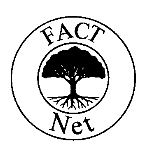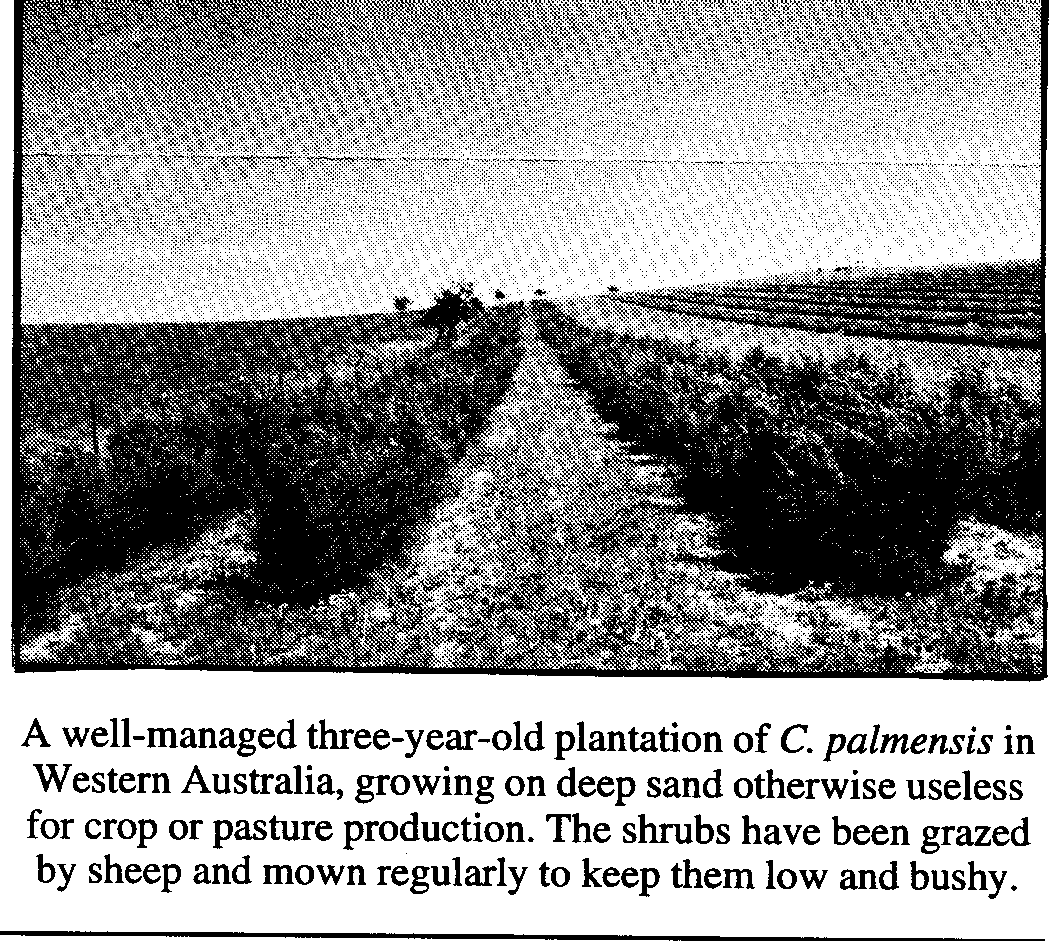Chamaecytisus palmensis: hardy, productive fodder shrub

NFTA 93-03, June 1993
A quick guide to useful nitrogen fixing trees from around the world
Chamaecytisus palmensis is a fast-growing shrub or small tree adapted to temperate regions with winter rains and prolonged, dry summers. In addition to producing high yields of palatable, nutritious fodder, the shrubs provide welcome shelter for livestock, help control soil erosion and salinization, increase soil fertility through nitrogen fixation, and produce nectar for bees. If allowed to develop, thick branches provide fuelwood that burns with intense heat.
Called “tagasaste” on the island of La Palma in the Canaries, where it originates, the species was formerly known as Cytisus proliferus. After its introduction to Australia, it was given the misleading common name of “tree lucerne” (Webb, 1982).
Botany
Chamaecytisus palmensis is a member of the Papilionoideae subfamily of legumes. If managed as a single-stemmed tree, it reaches heights of 7 to 8 m, but its common growth form is a multi-stemmed, spreading shrub of 5 to 7 m. The branches droop, the leaves are on short petioles, and the single lanceolate leaflets are pubescent below. Seed pods are 4 to 5 cm long. They become black on ripening, and contain 8 to 12 black seeds. About 35,000 to 40,000 seeds weigh 1 kg.
The shrubs have no thorns and produce profuse masses of fragrant white pea-like flowers in early spring, making them attractive ornamental plants. The white flowers distinguish C. palmensis from related, unpalatable species that have yellow flowers.
Ecology
To date, successful growth has been restricted to temperate regions with wet winters and dry summers, with annual rainfall ranging from 350 to 1600 mm (Douglas, 1987). The shrubs tolerate
a wide range of temperatures: They grow vigorously to the southern tip of New Zealand (46°S) and are naturalized in Australia as far north as Toowoomba (27°S). They are found from sea level to elevations of 1000 m and are reported to survive at 3000 m in Ethiopia (ILCA, 1987).
Cultivars develop that are suited for specific environments. In Australia, seedlings proliferate vigorously along roadsides near Orange, New South Wales, despite annual frosts down to -15°C.
Seedlings survive with equal vigor in deep coastal sands in the hot and arid climate of Geraldton, Western Australia.
Chamaecytisus palmensis establishes most easily on sandy-surfaced soils, but tolerates a wide range of soil types including gravels, loams, acid laterites and limestones. The shrubs tolerate a pH range of 5.0 to 7.0, but require soils that are free draining. Under waterlogged conditions, they are susceptible to root rot and mortality is high.
Seedlings are remarkably drought resistant and can survive six months of hot weather without rain or irrigation. Of more importance, established shrubs have a remarkable capacity to recover from defoliation. Regrowth occurs even in the prolonged absence of rain.
Distribution
Chamaecytisus palmensis is endemic to the arid volcanic slopes of La Palma in the Canary Islands. The shrub was introduced to Australia in 1879. It is now also common in New Zealand and has been introduced to parts of Africa.

Uses: fodder
For centuries, farmers in the Canaries depended on C. palmensis to maintain their livestock through the long dry summers. However, the species did not gain international recognition until the 1980s.
In Australia, the apparent need for manual or mechanical harvesting was initially a serious deterrent to farmers. Subsequently, the demonstration that sheep and cattle can browse the shrubs directly without detriment to the plants has led to greatly increased use. Well-managed plantations remain fully productive without irrigation for many years (Snook, 1952; 1982). They require little attention beyond annual application of fertilizer and periodic lopping.
Composition. The foliage has a composition similar to best-quality alfalfa. Material eaten by grazing animals can be expected to contain 17 to 22% crude protein, depending on the stage of growth and severity of grazing. The leaves and fine stems of fresh regrowth may contain 25 to 29% crude protein (dry matter) and only 16 to 19% crude fiber. The foliage is free from toxic substances.
Nutrient composition varies according to soil fertility. In particular, minerals such as calcium and phosphorus are reduced in foliage grown on mineral-deficient soils. Leaves have high in-vitro dry-matter digestibility (0.77 to 0.82). Stem digestibility is lower (0.59), but still adequate for feeding
(Borens and Poppi, 1986). The fodder contains protein, vitamins and minerals that are lacking in poor-quality roughage. Used as a supplement, it increases consumption of dry mature grass and
improves roughage utilization. Normally C. palmensis foliage is readily consumed by all grazing animals–including rabbits, pigs and poultry–but there may be some hesitation when it is first
introduced.
Yield. In regions with annual winter rains of 600 to 1000 mm, established shrubs planted in rows 5m apart can produce 15 to 20 kg of edible dry matter/plant when harvested once a year. In-row
spacing can vary from 25 cm to 2 m. At a planting density of 1,000 trees/ha, annual yields of 15 to 20 t/ha can be expected (Snook, 1986). Under current systems of dryland farming in Western Australia, plantations should produce at least 10 t/ha of edible dry matter from a single annual grazing or cutting. This is equivalent to 1.5 kg each for 18 sheep every day of the year. If plantations are harvested three or four times a year, or subjected to rotational or continuous grazing, yields can be even higher.
Silviculture
Establishment. The small black seeds are extremely hard and must be scarified or treated with boiling water to ensure quick germination. Hot-water treatment consists of dropping the seeds into boiling water and immediately lifting them out. They should not remain in the water for more than one minute.
In Australia, most plantations are established by direct seeding. Contractors have developed special machinery to do this in one operation. A blade or “scalper” removes a strip of surface soil to clear away weed growth. This is followed by a ripper which opens the soil so that fertilizer and seed can be placed in lines. Finally, a following wheel compacts the soil over the seeds.
In most situations, C. palmensis readily makes use of rhizobia present in the soil. However, to insure nodulation, seed should be treated with cowpea inoculum or an inoculum specific for the
species.
It is important to apply adequate fertilizer with the seed. This will encourage deep rooting and the development of robust plants that can withstand the first summer. Fertilizer should be applied as recommended for other legumes at each specific site. In most cases soluble phosphate will be the main requirement, but if additional essential plant minerals are lacking, these must be supplied. In Western Australia, for example, superphosphate with copper and zinc should be applied at seeding at a rate of 200 kg/ha.
Seedlings transplant very well and are commonly used for establishment in small areas, on steep slopes or where stones prevent the use of machinery. Animal-proof fences are essential for the first two to three years to protect young seedlings from grazing animals. Rabbits and hares are particularly fond of the seedlings and must be excluded. Mature plants recover remarkably well, even from severe overgrazing, if early regrowth is protected.
Most plantations consist of shrubs planted in parallel rows about 5 m apart, although distance between rows can be varied. Interplanted crops grow well because the shrubs provide protection from cold and drying winds.
Management. Experience shows that shrubs in plantations must be kept short and bushy. When seedlings are about 10 months old, they should be cut with a mower or grazed. This encourages the formation of bushes with multiple stems. The time and frequency of further harvests or grazing will be determined by the rate of growth. Until recently, the common practice was to graze or cut the shrubs once a year. Even when grazing is severe, vigorous leaders remain, and it is essential to lop these annually.
The need for annual lopping can be reduced or eliminated by grazing the shrubs three or four times a year or on a continuous basis. Under such management, vigorous, upright shoots are eaten before they become too robust.
Obviously, the shrubs must not be overgrazed to the extent that regrowth is eaten before root vigor is restored. When grazing pressure is too high, the animals may inflict serious damage by eating the bark. This problem is rare with good management: It is difficult for the animals to tear off bark from shrubs with a bushy growth habit and multiple stems.
Fertilizer. For continued high yields of nutritious fodder, regular application of the appropriate fertilizer is essential. In Western Australia, superphosphate and potash (3:2) should be applied annually at a rate of 200 kg/ha. Application of micronutrients, such as calcium, may also be necessary. The shrubs may continue to grow despite a lack of essential minerals but the quality and palatability of the foliage will decline steadily.
Limitations
In Australia, C. palmensis is remarkably free of pests and there is no evidence of viral infection. Slugs, cutworms and grasshoppers eat emerging seedlings, but one application of insecticide at seeding appears to give adequate protection. Mature shrubs are the last crop plants to be attacked by grasshoppers or locusts, and even when all the foliage is eaten, the plants make a rapid recovery when the swarms pass on. The species’ requirement for fertilization to maintain high levels of productivity and nutrient content poses a management limitation for resource-poor farmers.
References
Borens, F. and Poppi, D.P. 1986. Feeding value of tagasaste. New Zealand Journal of Agricultural Science. 20:149-51.
International Livestock Center for Africa (ILCA). 1987. Forage Network in Ethiopia Newsletter. Addis Ababa: ILCA, pp. 21-23.
Snook, L.C. 1952. Tree Lucerne: a fodder crop which has been overlooked. Journal of the Department of Agriculture of Western Australia. (3):587-93.
Snook, L.C. 1982. Tagasaste (tree lucerne): a shrub with high potential as a productive fodder crop. Journal of the Australian Institute of Agricultural Science. 48:209-14.
Snook, L.C. 1986. Tagasaste (tree lucerne): high production fodder crop. Shepparton (Australia): Night Own Publishers, 102pp.
Webb, C.L. 1982. Tree lucerne: its taxonomic status and naturalization in New Zealand. In Tree lucerne in New Zealand. Christchurch (New Zealand): Division of Scientific and Industrial
Research, pp. 2-5.
This issue was prepared by Laurence C. Snook, retired agricultural scientist and farmer, Box 54, Margaret River, WA 6285, Australia. Material was added by NFTA staff.
A publication of the Forest, Farm, and Community Tree Network
